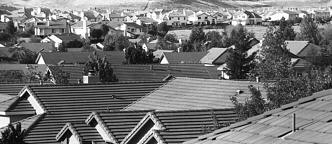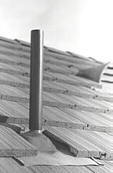Ventennas are constructed from rugged ABS plastic tubing. As such, they are virtually indestructible. They are designed to fit over a 1-1/2 inch roof vent pipe (see the write-up about pipe sizes , but may be adapted for sizes from 1 to 3 inches, and should be mounted only on plastic vent pipes. The Ventenna is hollow, thus it does not disrupt the vent function in any way.
There are other mounting possibilities for the Ventenna, including making it very stealthy, placing it anywhere on the roof, putting it on on a porch or balcony, or installing it inside the attic. Here is the complete list of mounting possibilities.


About Ham Ventennas
The normal "ABS Black" color of the outside of the Ventenna may be painted with any non-metallic-based paint. This allows you to match the Ventenna to the other fixtures on the rooftop, making it as stealthy as possible.
As to the radiation pattern - The Ventenna has a pattern like a vertically-oriented dipole. This means that the 6 dB down point in the pattern will be at a depression angle of about 60 degrees. So, even if you are high up in the air - say in a New York apartment - you should be able to access stations lower than you quite easily. (FYI - 6 dB signal change is one "S" unit on the receiving radio's "S" meter.) The horizontal radiation pattern of the Ventenna is essentially omnidirectional.
Ventennas are guaranteed to be under 2:1 SWR over the specified operating range, and, at about the middle of the range, the SWR will be at or below 1.2:1. For special-frequency Ventennas, the 2:1 SWR bandwidth is typically +/- 1.25%.
Power Ratings. - Below 800 MHz, the power limitation is 200 Watts, due to the RG-58 cable used. Above 800 MHz, the power is limited to 100 Watts, due to the construction of the antenna.
Ventennas are normally supplied with the coax coming out the side, a few inches up from the bottom. The coax is about three feet long, terminated in a BNC-M connector. You connect your coax to this pigtail and run it to a convenient location for entry into the building. As an option, the coax can be run down inside the pipe, for complete stealth. See the write-up on Inside Coax for a description of the installation possibilities for this option.














